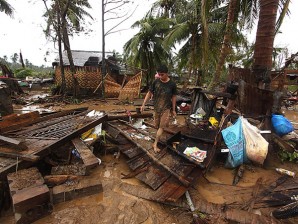
AFP PHOTO
NEW BATAAN, Compostela Valley – The task of rebuilding Compostela Valley from the devastating effects of Typhoon “Pablo” would take “years and billions of pesos” to complete, the provincial governor said Friday as local officials and residents tried to cope with the rising death toll.
Over 70 percent of the province’s area was devastated, with damage to agriculture alone pegged at almost P4 billion, according to Governor Arturo Uy.
While the people of Compostela Valley could in time overcome their grief over their dead—the official tally stood at 201 as of late Thursday— and missing relatives— 406—Uy said regaining their livelihood would be quite difficult.
“The saddest part is that ‘Pablo’ literally wiped out people’s livelihood. People depend on agriculture and it was that sector that was hit so hard,” Uy told the Inquirer here on Friday.
Donations from the local and the national governments as well as from the private sector began to trickle in a day after Tuesday’s devastation, but Uy said the aid so far received was simply not enough. More was needed to bring normalcy back, he said.
Uy said the provincial government would first attend to the “immediate temporary needs” of those affected. “Food and clothing first, and prioritize the search operations in New Bataan,” he said.
Uy said the affected families cannot stay for long in schools, gymnasiums and other public buildings so the government has to look for safer and more permanent places for them.
About 24,700 families or over 120,000 people were displaced in Compostela Valley, according to figures released by the Provincial Disaster Risk Reduction Management Council. The province has a population of about 700,000.
“Our bigger problem now is where will these people stay?” the governor said.
Uy also reacted to reports (not in the Philippine Daily Inquirer) that the people of the province were ill-prepared despite warnings about the strong typhoon’s approach being repeatedly made days before it actually made landfall.
“With the magnitude [of the destruction] caused by the typhoon, our preparations were put to naught,” he said, urging unity.
“Let’s be strong. Maybe this is just a test for us. We would strive to address your concerns. Please just bear with us if we cannot address your needs right away,” he said.
In Cateel, Davao Oriental, food and medicine were also scarce for a pop[ulation of about 50,000, according to Mayor Carmelo Nuñez.
“Practically, everybody here is affected,” he said.
Relief goods have started coming in, but Nuñez said they were not enough.
While money was needed to procure food and medicines for the typhoon victims, a state of calamity, which would enable the local government to draw a portion of its annual budget, had yet to be formally declared.
Nuñez said the Sangguniang Bayan has yet to convene, nearly a week since Pablo made landfall in Davao Oriental.
Typhoon victims were seen foraging and scavenging for food.
At the town center, the Inquirer saw a group of residents dividing a sack of rain-drenched rice.
Emotions ran high among typhoon victims as food was scarce.
A group of residents even asked the Inquirer if taking photos of the devastation would do them any good.
“Sana makarating sa labas na wala na kaming kinakain dito,” one resident said.
Leopolda Casina, 48, a mother of seven, said no assistance had reached them as of yet.
“Wala talaga,” she said outside a shanty fashioned from material salvaged from what used to be her home in the village of Maribojoc.
Casina said they lost their means of livelihood. The fishing banca the family has owned was swept away during the typhoon.
Asked what she would do, Casina said: “I don’t know. We will take it slowly.”
Injured residents also continued to flock to the town’s district hospital, which has been condemned after Pablo blew its ceiling off. At least three patients were now lying on hospital beds in an adjacent building. Its two physicians were spotted attending to out-going patients.
Medicines were lacking and many patients were seen leaving a makeshift hospital without getting treatment. For example, Angela Inabuan, 42, left without getting an anti-tetanus shot for a wound on the left foot.
“I stepped on a nail,” she said.
In North Cotabato, the excess water that Pablo dumped in northern and eastern Mindanao finally found its way into the Rio Grande de Mindanao Friday and caused it to swell even more.
In Kabacan town, 13 villages were now submerged and about 1,722 families had to flee, North Cotabato Governor Emmylou Taliño-Mendoza said.
In Maguindanao, Gov. Esmael Mangudadatu said 600 families from Montawal and Pagalungan towns, both of which Rio Grande traverses, had fled toward the national highway as water inundated their villages.
Loreto Rirao, Civil Defense director for the Autonomous Region in Muslim Mindanao, said a team from the Regional Disaster and Risk Reduction Management Council had been deployed to assist the evacuees and provide them temporary shelter.
Mangudadatu said as the water in the Rio Grande continued to rise, and the towns of Datu Piang, Rajah Buayan, Mamasapano, Kabuntalan, and Sultan sa Barongis were being closely watched. These towns lie along the river’s course leading to the Liguasan Marsh.